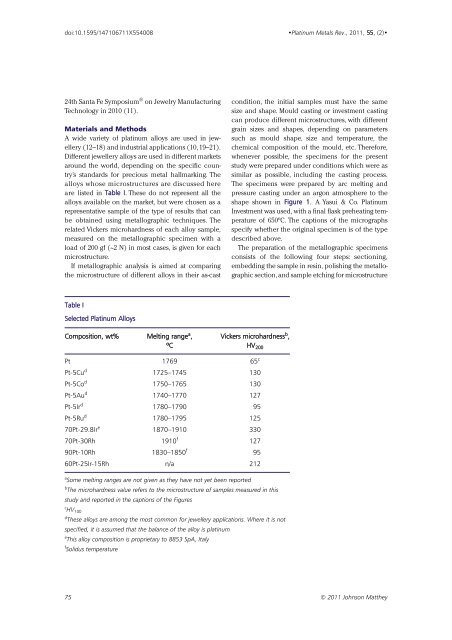Download - Platinum Metals Review
Download - Platinum Metals Review
Download - Platinum Metals Review
You also want an ePaper? Increase the reach of your titles
YUMPU automatically turns print PDFs into web optimized ePapers that Google loves.
doi:10.1595/147106711X554008<br />
•<strong>Platinum</strong> <strong>Metals</strong> Rev., 2011, 55, (2)•<br />
24th Santa Fe Symposium ® on Jewelry Manufacturing<br />
Technology in 2010 (11).<br />
Materials and Methods<br />
A wide variety of platinum alloys are used in jewellery<br />
(12–18) and industrial applications (10, 19–21).<br />
Different jewellery alloys are used in different markets<br />
around the world, depending on the specific country’s<br />
standards for precious metal hallmarking. The<br />
alloys whose microstructures are discussed here<br />
are listed in Table I. These do not represent all the<br />
alloys available on the market, but were chosen as a<br />
representative sample of the type of results that can<br />
be obtained using metallographic techniques. The<br />
related Vickers microhardness of each alloy sample,<br />
measured on the metallographic specimen with a<br />
load of 200 gf (~2 N) in most cases, is given for each<br />
microstructure.<br />
If metallographic analysis is aimed at comparing<br />
the microstructure of different alloys in their as-cast<br />
condition, the initial samples must have the same<br />
size and shape. Mould casting or investment casting<br />
can produce different microstructures, with different<br />
grain sizes and shapes, depending on parameters<br />
such as mould shape, size and temperature, the<br />
chemical composition of the mould, etc. Therefore,<br />
whenever possible, the specimens for the present<br />
study were prepared under conditions which were as<br />
similar as possible, including the casting process.<br />
The specimens were prepared by arc melting and<br />
pressure casting under an argon atmosphere to the<br />
shape shown in Figure 1. A Yasui & Co. <strong>Platinum</strong><br />
Investment was used, with a final flask preheating temperature<br />
of 650ºC. The captions of the micrographs<br />
specify whether the original specimen is of the type<br />
described above.<br />
The preparation of the metallographic specimens<br />
consists of the following four steps: sectioning,<br />
embedding the sample in resin, polishing the metallographic<br />
section, and sample etching for microstructure<br />
Table I<br />
Selected <strong>Platinum</strong> Alloys<br />
Composition, wt% Melting range a , Vickers microhardness b ,<br />
ºC HV 200<br />
Pt 1769 65 c<br />
Pt-5Cu d 1725–1745 130<br />
Pt-5Co d 1750–1765 130<br />
Pt-5Au d 1740–1770 127<br />
Pt-5Ir d 1780–1790 95<br />
Pt-5Ru d 1780–1795 125<br />
70Pt-29.8Ir e 1870–1910 330<br />
70Pt-30Rh 1910 f 127<br />
90Pt-10Rh 1830–1850 f 95<br />
60Pt-25Ir-15Rh n/a 212<br />
a Some melting ranges are not given as they have not yet been reported<br />
b The microhardness value refers to the microstructure of samples measured in this<br />
study and reported in the captions of the Figures<br />
c HV 100<br />
d These alloys are among the most common for jewellery applications. Where it is not<br />
specified, it is assumed that the balance of the alloy is platinum<br />
e This alloy composition is proprietary to 8853 SpA, Italy<br />
f Solidus temperature<br />
75 © 2011 Johnson Matthey
















